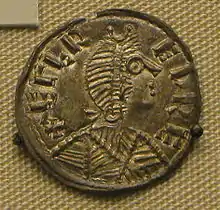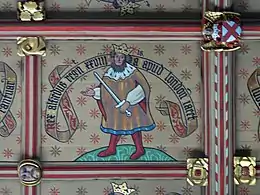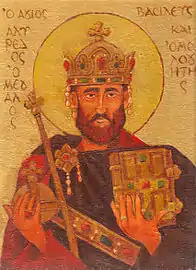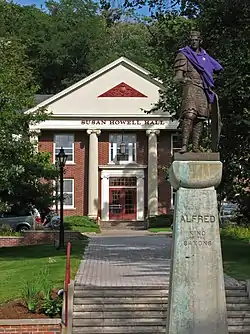Cultural depictions of Alfred the Great
Alfred the Great was an Anglo-Saxon king (871 – 899) of Wessex an Anglo-Saxon kingdom, that existed from 519 to 927 south of the river Thames in England. In the late 9th century, the Vikings had overrun most of the Anglo-Saxon kingdoms that constituted England at the time. Alfred's reign has become regarded as pivotal in the eventual unification of England, after he famously defended Wessex and southern England against the overwhelming Vikings invasions, winning a decisive victory at the Battle of Edington in 878.

Most of what we know about the historical Alfred comes his biography Life of King Alfred written, during Alfred reign by his direction, in 893 by a welsh monk Asser. It was not until the English Reformation in the sixteenth century, that Alfred was first given the epithet "the Great" when he was seen as the ideal Christian sovereign. Over 600 years after his life, that Alfred began to inspired many artistic and cultural works from the sixteenth century onwards, with a height in the Victorian Period.
The cult of Alfred developed into a significant cultural force in literature, the visual arts, and national consciousness. The lists and images on this page cover depictions or references to Alfred in a wide range of media, including works of art, literature, histories and plays all usually favourably or heroically; and educational establishments named in his honour. Plus more recent representations of him in popular culture, screen and fiction and even video games.
Background to Alfred's growing reputation
Alfred was the youngest son of King Æthelwulf of Wessex, his father died when he was young and three of Alfred's brothers ruled and died in battle before he ascended to the throne in 871. Alfred spent his first seven years of his reign battling the Viking forces, until with Wessex (the last of the Anglo-Saxon kingdoms) half overrun he decisively defeated the Great Heathen Army at the Battle of Edington in 878AD; subsequently the Vikings settled towards the east side of England. Following this, it is recorded that, Alfred reorganised national military service, improved Wessex's defence by building a ring of 33 'burhs' (fortified settlements) and designed and built a small fleet of longship, to protect against further Viking threats. From this base, his daughterÆthelflæd and son Edward the Elder began the conquest of the rest of England from Viking control. As Alfred's reign was pivotal it has often been regarded as the first in the lists of English monarchs.
Alfred gathered advisers from across England, Wales and Francia to his court including a Welsh monk and scholar named Asser. Alfred's positive image was perhaps over-emphasised by Asser who Alfred commissioned to write his biography The Life of King Alfred, the first for an English ruler. (The manuscript survives in only one copy, which was part of the Cotton library). Asser portrays his king 'as the embodiment of the ideal, but practical, Christian ruler'. Alfred’s reign is notable for a rebirth of learning, several works were translated from Latin into Old English, with some credited to Alfred himself, works that were considered "most necessary for all men to know", he made education reforms (including advocacy of education in the English language rather than in Latin) and he established schools to provide education for future priests and secular administrators, so that they might be better in their legal judgements. Alfred issued a new law code and commissioned the Anglo-Saxon Chronicle a collection of annals in Old English that recorded the historical events in England up until 1154.[1]
Asser presents Alfred as saintly, however Alfred was never canonised (in 1441 Henry VI of England attempted unsuccessfully to have him canonized by Pope Eugene IV), so in later catholic medieval England artists turned to the royal Anglo-Saxon saints such as Saint Edmund the Martyr and Saint Edward the Confessor, for inspiration as subjects. (Though venerated at times in the Catholic Church, the current "Roman Martyrology" does not mention Alfred.)[2][3] While he was not venerated in art, the medieval historians William of Malmesbury, Matthew Paris and Geoffrey of Monmouth further reinforced Alfred's favourable image of a pious Christian ruler.[1]
In the Sixteenth century Alfred became the ideal symbolic champion for the rising English Protestant church during the English Reformation. Alfred encouraged the use of English rather than Latin in education, and his translations were viewed as untainted by the later Roman Catholic influences. Archbishop Matthew Parker published an edition of Asser’s Life of Alfred in 1574. It was at this time, over 600 years after his death, Alfred was first given the epithet "the Great". The designation was maintained by those who admired Alfred's perceived patriotism, his undoubted success against barbarism, promotion of education, and establishment of the rule of law. The comparatively greater amount of written information from his reign, including his law code and Asser’s account of Alfred's thoughts on law, education and administration helped. The historical Alfred evolved into the increasingly popular legendary Alfred. The Anglican Communion venerated him as a Christian hero, with a feast day or commemoration on 26 October, and he is often be found depicted in stained glass in Church of England parish churches.[4] He became the ideal unthreatening example of a ruler when discussing the ideal monarch and the roles of monarchy in a modern state, at the same time Eighteenth-century British royals like Frederick, Prince of Wales were able to draw upon Alfred's popularity in creating their own royal images. The cult of King Alfred the Great increased until by the reign of Victoria, Alfred was perceived as founder of the English nation and an archetypal symbol of the nation's perception of itself. He has been seen as a heroic figure, who centuries after his death inspired many artistic and cultural works. During this period, the name ‘Alfred’ became a popular Christian name, with Queen Victoria in 1844 naming her second son Prince Alfred. In 1870, Edward Augustus Freeman called Alfred the Great ‘the most perfect character in history'.[5] 'Alfredophilia' and 'Alfredomania', found expression in religious, legal, political and historical writing, and in poetry, drama, music, and prose, and in sculpture, painting, engraving, and book-illustration.[6] History has been kind to Alfred, he was not titled Great in his own historical period, but in 2002 he was still ranked number 14 in the BBC's poll of the 100 Greatest Britons.[1][7][8]
Art and sculpture
There are no surviving images of Alfred from his reign, except on his coins.
 A coin of Alfred, king of Wessex |
 13th century depiction of Alfred the Great |
Artistic images of King Alfred began to flourish mainly from 18th to the early 20th century. In 1734–1735 Alfred’s bust was included as one of the Whig historical champions in ‘The Temple of British Worthies’, in the English landscape gardens of Stowe House created by William Kent. Representations of Alfred proliferated, with Alfred often depicted as the archetypical symbol of the English nation: as a heroic military commander, a wise scholar and upholder of justice. Those who could not own sculpture or high art could possess a decorative image of 'England's Darling' in the fashionable genre of History painting, amongst which the most common examples were Alfred disguised in the Danish camp and Alfred burning the peasant woman's cakes.[1][8]
 King Alfred's bust at the ‘The Temple of British Worthies’ at Stowe House 1734–1735. |
 Alfred in the Isle of Athelney, receiving News of a Victory over the Danes (a 1751 print, after Nicholas Blakey). |
 18th century portrait of Alfred by Samuel Woodforde |
_p1.102_ALFRED_THE_GREAT.jpg.webp) Taken from Thomas Mante's Naval and Military History of the Wars of England, including those of Scotland and Ireland, (1800) p1.102 |
 King Alfred painted vault over the choir area in St. Mary's Church, Beverley, East Riding of Yorkshire, England. |
 King Alfred the Great pictured in a stained glass window in the West Window of the South Transept of Bristol Cathedral, by Arnold Wathen Robinson |
 Eastern Orthodox Ikon of King St. Alfred the Great |
.jpg.webp) 19th century painting of King Alfred (The Great) |
 Statue of Alfred the Great at Wantage, Berkshire, 1877. |
 Alfred the Great at the Battle of Ashdown by Morris Meredith Williams (1913) |
.jpg.webp) The Boyhood of Alfred the Great (1913) |
 1904, Alfred the great in the Danish invaders camp |
Historical writing
Alfred is the subject of several historical works. Early examples include:
| Date | Title | Author | Notes |
|---|---|---|---|
| (1570 edition) | *Foxe's Book of Martyrs | John Foxe | [1][9] |
| (1634) | *Life of Alfred | Robert Powell | [1][10] |
| (1642) | *Life of King Alfred | Sir John Spelman | [1][11] |
Literature
Alfred is the subject of several works of historical fiction. These include:
| Date | Title | Author | Notes |
|---|---|---|---|
| (1723) | *Alfred | Sir Richard Blackmore | An Epick Poem in Twelve Books. [1] Dedicated to Prince Frederick, the eldest son of King George II. The poem was ostensibly about King Alfred the Great, but like Blackmore's earlier Arthurian epics, it was also a means to express his partisan view of the political events of his time. |
| (1801) | *Alfred | Henry James Pye | epic poem[12] |
| (1801) | *Alfred | Joseph Cottle | epic poem[13] |
| (1808—1834) | *King Alfred | John Fitchett (poet) | An epic poem, Fitchett spent forty years researching and writing it. It was printed at Warrington for private circulation, in five quarto volumes. It was cast in the form of a romantic, based on the life and times of King Alfred. Fitchett did not live to finish the work, which was completed by his friend Robert Roscoe who added the final 2,585 lines to the poem. The entire work contains more than 130,000 lines.[14] |
| (1830) | *Sea-Kings in England: an historical romance of the time of Alfred | Edwin Atherstone | A historical romance novel set during king Alfred's war against the Viking invasions [15][16] |
| (1861) | *A Chronicle of Ethelfled | Anne Manning | Focusing on the relationship between Alfred and his daughter Æthelflæd.[17] |
| (1886) | *The Dragon and the Raven, or The Days of King Alfred | G. A. Henty | Drawing on the his experience as a war correspondent Henty gives vivid picture of the horrors of the Danish invasions. The story of young Edmund, who joins Alfred's struggle against the hordes of marauding invaders. "Impeccably researched and extremely fast-paced".[18] |
| (1901) | *The King's Sons: A Story of King Alfred's Boyhood , | G. Manville Fenn | A children's novel.[17] |
| (1911) | *The Ballad of the White Horse, | G. K. Chesterton | Written in ballad form, the work has been described as one of the last great traditional epic poems written in the English language, it depicts Alfred as a divinely oriented leader waging holy war, uniting the Kingdoms of Britain against the Vikings. It depicts Alfred.[19] The poem is about the idealised exploits of Alfred the Great and how he was victorious over the invading Danes following a vision of the Virgin Mary.[20] |
| (1943) | *The King Liveth | Jeffrey Farnol | [21][22] |
| (1961) | *The King of Athelny | Alfred Duggan | A historical novel biography a mixture of uncontested facts, as well as some stories of less authenticity, such as the burning of the cakes. |
| (1964) | *The Namesake | C. Walter Hodges | Children's historical novel in which King Alfred is an important character.[23][24] |
| (1967) | *The Marsh King | C. Walter Hodges | Children's historical novel[23][24] |
| (1990) | *The Edge of Light | Joan Wolf | Historical novel about life and times of Alfred the Great |
| (June 1993) | *The Hammer and the Cross | Harry Harrison and John Holm (a pseudonym of Tom Shippey) | An alternative history science fiction novel, the first in a trilogy.[25] |
| (2004) | * The Last Light of the Sun | Guy Gavriel Kay | Historical fantasy novel Alfred is thinly disguised under the name King Aeldred |
| (2004–2020) | *The Saxon Stories | Bernard Cornwell | A series of 12 historical novels in which Alfred is portrayed as a pious and physically weak individual. Although unassuming, he is possessed of an iron will and, ultimately, becomes a significant barrier to Viking ambitions simply by being alive. Later adapted for television as The Last Kingdom.[26] |
| (5 December 2013 UK) (14 January 2014 US/CAN) | *In The Late Scholar | Jill Paton Walsh | The plot takes place in 20th Century Oxford University, there is a central role to a manuscript attributed to King Alfred, and the characters frequently discuss him.[27] |
Theatre, operas and other vocal works
Alfred is the subject of several works of historical drama. These include:
| Date | Title | Composer/Writer | Genre | Notes |
|---|---|---|---|---|
| (1740—1753) | * Alfred | music by Thomas Arne and a libretto by David Mallet and James Thomson. | a masque/Opera | This work was first performed on 1 August 1740, at Cliveden, country home of Frederick, Prince of Wales, as a celebration of the anniversary of his grandfather's, King George I's royal accession to the throne of Great Britain. From it the patriotic anthem "Rule, Britannia!" originates. During the French Wars (1793-1815), patriotic plays, opera and ballets about Alfred became popular often concluding with a rousing rendition of the Thompson's and Arne’s ‘Rule Britannia’, as the new anthem became a favoured way to express allegiance to the sovereign.[28][1][29] |
| (1827) | *Alfred the Great; or, the Enchanted Standard | Issac Pocock | light operatic comedy | A musical drama, in two acts [30] |
| (1829) | *Alfred the Great | Sarah Hamilton | a drama; in five acts | [31] |
| (1837) | *Alfred the Great; or The Patriot King | James Sheridan Knowles | Drama | [32] |
Depictions on screen
Depictions on film and television screen include:
| Date | Title | Format | Notes | Ref |
|---|---|---|---|---|
| 1969 | *Alfred the Great | epic film | Directed by Clive Donner, with David Hemmings playing Alfred, the film received negative reviews and was not a commercial success. | [33][34][35] |
| 1971 | *The Raven and the Cross | A UK children's BBC television (TV) serial | by John A. Tully, about Alfred's conflict with Guthrum. | [36][37] |
| 1974 | *King Alfred | episode 4 of BBC's Churchill's People | Alfred is played by Alan Howard. | |
| 2009 and 2015 | *Horrible Histories and their rebooted series | A UK CBBC Children's TV series | In this light hearted children's educational history sketch series Alfred is portrayed in various episodes by Mathew Baynton/Tom Rosenthal | [38] |
| 2015 -2018 | *The Last Kingdom | A BBC America, and on BBC Two television series adaptation of The Saxon Stories | Alfred is played by David Dawson for the first three seasons of the series. | [39][40] |
| 2015–2020 | In Vikings | History (Canadian TV network) series | From season 3 to 4, Alfred is portrayed by various actors throughout his childhood and in seasons 5 and 6 by Ferdia Walsh-Peelo as an adult; however, he is depicted as the bastard son of Athelstan by Aethelwulf's wife Judith (based on Judith of Flanders), but is nonetheless raised as Aethelwulf's legitimate son. | [41] |
Video games
Alfred is the faction leader for Wessex in the 2018 strategy game Total War Saga: Thrones of Britannia.
In the 2020 game Assassin's Creed Valhalla, King Aelfred of Wessex is leading the Saxons against the vikings and acts as the main overarching antagonist of the story.[42][43]
Education

A number of educational establishments are named in Alfred's honour:
- The University of Winchester created from the former King Alfred's College, Winchester (1928 to 2004)[44]
- Alfred University and Alfred State College in Alfred, New York; the local telephone exchange for Alfred University is 871 in commemoration of Alfred's ascension to the throne.[45]
- The University of Liverpool created a King Alfred Chair of English Literature[46]
- King Alfred's Academy, a secondary school in Wantage, Oxfordshire, the birthplace of Alfred
- King's Lodge School in Chippenham, Wiltshire, so named because King Alfred's hunting lodge is reputed to have stood on or near the site of the school
- The King Alfred School and Specialist Sports Academy, Burnham Road, Highbridge, so named due to its rough proximity to Brent Knoll (a Beacon site) and Athelney
- The King Alfred School in Barnet, North London, UK
- King Alfred's house in Bishop Stopford's School at Enfield
Military
The Royal Navy has named one ship and two shore establishments HMS King Alfred, and one of the first ships of the US Navy was named USS Alfred in his honour.
Citations
- Yorke 1999.
- "Archived copy". Archived from the original on 2 August 2019. Retrieved 2 August 2019.CS1 maint: archived copy as title (link)
- Foot 2011, p. 231.
- Horspool 2006, pp. 190–91.
- Yorke, Barbara (10 October 1999). "Alfred the Great: The Most Perfect Man in History?". History Today Volume 49 Issue 10. History Today. Retrieved 29 June 2020.
- Keynes, S. (26 September 2008). "The cult of King Alfred the Great". Anglo-Saxon England, volume 28. Cambridge University Press. pp. 225–356. Retrieved 6 February 2019.
- "100 great British heroes". BBC News. 21 August 2002.
- Joanne Parker (15 October 2007). England's Darling: The Victorian Cult of Alfred the Great. Manchester University Press. ISBN 978-0-7190-7356-4.
- John Foxe (1844). Fox's Book of Martyrs: The Acts and Monuments of the Church. G. Virtue. pp. 195–.
- Robert POWELL (Attorney) (1634). The Life of Alfred, Or Albred. ... Together with a Parallell of ... K. Charles Until this Yeare 1634. R. Badger for T. Alchorn. pp. 80–.
- Joanne Parker (15 October 2007). England's Darling: The Victorian Cult of Alfred the Great. Manchester University Press. pp. 57–. ISBN 978-0-7190-7356-4.
- The Editors of Encyclopaedia Britannica (ed.). "Henry James Pye". Encyclopaedia Britannica. Retrieved 1 July 2020.
- Pratt, L. (2000). "Anglo-Saxon attitudes?: Alfred the Great and the Romantic national epic. In D. Scragg & C. Weinberg (Eds.), Literary Appropriations of the Anglo-Saxons from the Thirteenth to the Twentieth Century". Cambridge Studies in Anglo-Saxon England. Cambridge University Press. doi:10.1017/CBO9780511518775.009. pp. 138–156. Retrieved 1 July 2020.
- Frank, Roberta (2003). "The Search for the Anglo-Saxon Oral Poet [1992 Northcote Toller Lecture]". In D. G. Scragg (ed.). Textual and material culture in Anglo-Saxon England: Thomas Northcote Toller and the Toller Memorial Lectures. DS Brewer. pp. 138–160.
- Edwin Atherstone (1830). The sea-kings in England: an historical romance of the time of Alfred. printed for Robert Cadell.
- "British Poetry of the later Eighteenth and Earlier Nineteenth Centuries". December 2004. University of Nebraska. Retrieved 1 July 2020.
- Ernest A. Baker (20 February 2015). A Guide to Historical Fiction - Scholar's Choice Edition. Scholar's Choice [George Routledge and Sons]. p. 9. ISBN 978-1-297-45781-4.
- "The dragon and the raven, or, The Days of King Alfred / G.A. Henty". National Library Wellington. Retrieved 14 July 2020.
- "Lecture 21: The Ballad of the White Horse – Society of Gilbert Keith Chesterton".
- Chesterton, G. K. (1911). The ballad of the white horse. London: Methuen. pp. 173–174.
- Pat Bryan (16 January 2002). Farnol: The Man Who Wrote Best-Sellers. iUniverse. p. 177. ISBN 978-0-595-21227-9.
- "THE KING LIVETH". Kirkus. Retrieved 2 July 2020.
- "Carnegie Medal Award". c. 2007. Curriculum Lab. Elihu Burritt Library, Central Connecticut State University (CCSU). Retrieved 1 July 2020
- "Hodges, C. Walter ...". WorldCat. Retrieved 22 July 2012.
- "The Encyclopedia of Science Fiction". 3rd ed. Sf-encyclopedia.com. 2011. Retrieved 1 July 2020.
- Lafferty, Hannah. "Bernard Cornwell Talks The Pagan Lord, The Challenges of Historical Fiction, And Future Plans". Emertainment Monthly. Boston: Emerson College. Archived from the original on 22 June 2014. Retrieved 9 June 2014.
- "Lord Peter Wimsey, John Freeman, Kate Mosse". BBC 4 - Open Book. BBC. 15 December 2013. Retrieved 1 July 2020.
- Alfred (King of England); David Mallet; James Thomson (1760). Alfred the Great; an oratorio. As perform'd at the Theatre Royal in Drury-Lane. The music compos'd by Mr. Arne. [Altered by David Mallet from the masque by James Thomson and D. Mallet.]. T. Lowndes. pp. 6–.
- Scholes 1970, p. 897.
- Isaac POCOCK (1827). Alfred the Great; or, the Enchanted Standard. A musical drama, in two acts, etc. pp. 1–.
- Alfred (King of England) (1829). Alfred the Great, a drama; in five acts. [By Sarah Hamilton. In verse.]. Longman & Company. pp. 69–.
- James Sheridan Knowles (1829). Alfred the Great; Or, The Patriot King: An Historical Play ... Jos. Robinson. pp. 32–.
- "Alfred the Great (1969)". BFI. Retrieved 1 July 2020.
- "Alfred the Great". Variety (Magazine). 13 December 1968. Retrieved 14 July 2020.
- "The Screen: 'Alfred the Great' Begins Local Run:Clive Donner Directs Ninth-Century Saga". The New York Times. 4 December 1969. Retrieved 14 July 2020.
- "The raven and the cross / John Tully". British National Bibliography. 1974. Retrieved 2 July 2020.
- "John Line obituary". The Guardian. 22 Aug 2018. Retrieved 7 July 2020.
- "Horrible Histories: Awesome Alfred the Great Special". Radio Times. Retrieved 2 July 2020.
- Runcie, Charlotte (23 October 2015). "The Last Kingdom, BBC Two, review: 'the thinking person's Game of Thrones'". The Daily Telegraph. London. Retrieved 2 July 2020.
- O'Grady, Sean (22 October 2015). "The Last Kingdom, TV review: This Viking saga is less silly than Game of Thrones – and less exciting, too". The Independent. London. Retrieved 2 July 2020.
- "'Vikings' Creator Breaks Down the Midseason Finale's Bloody Battle". Variety. 5 February 2020. Retrieved 2 July 2020.
- "Assassin's Creed Valhalla Gameplay, Story Details Revealed - IGN". Retrieved 2020-05-01.
- "Assassin's Creed Valhalla: Who is King Alfred?". Den of Geek. 2020-05-05. Retrieved 2020-05-10.
- "Full details of universities 'at risk'". The Guardian. 20 July 2007. Retrieved 2 July 2020.
- Susan Rumsey Strong (5 June 2008). Thought Knows No Sex: Women's Rights at Alfred University. SUNY Press. pp. 13–. ISBN 978-0-7914-7514-0.
- Oxford Classics: Teaching and Learning 1800-2000. Bloomsbury Publishing. 12 December 2013. pp. 86–. ISBN 978-1-4725-3781-2.
References
- Horspool, David (2006). Why Alfred Burned the Cakes. London: Profile Books. ISBN 1-8619-7786-7.
- Scholes, Percy (1970). The Oxford Companion to Music (tenth ed.). Oxford University Press.
- Yorke, Barbara (1999). "Alfred the Great: The Most Perfect Man in History?". History Today. Archived from the original on 15 February 2016.